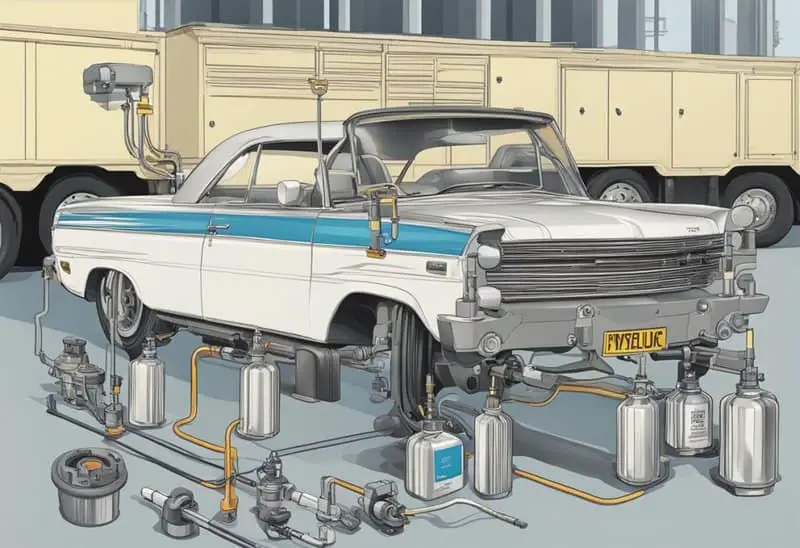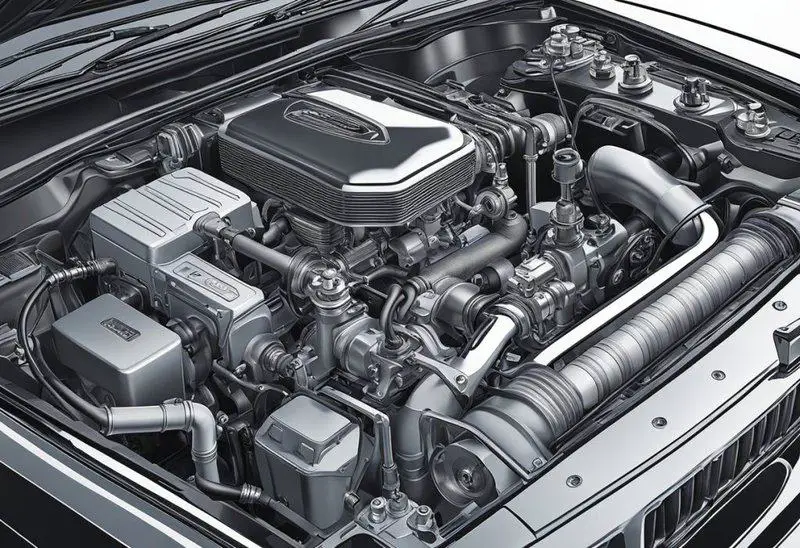Power steering fluid and hydraulic fluid are two different types of fluids that are used in automobiles. Power steering fluid is a type of hydraulic fluid that is used to reduce the amount of effort required to turn the steering wheel. It creates a hydraulic link between the steering wheel and the front wheels, which makes it easier to turn the wheels. Power steering fluid also lubricates the moving parts within the steering system and prevents corrosion.

Hydraulic fluid, on the other hand, is a type of fluid that is used to transfer power within a hydraulic system. It is used in a variety of applications, including brakes, clutches, and transmissions. Hydraulic fluid is also used in power steering systems, but it is not the same as power steering fluid. In some cases, hydraulic fluid can be used as a substitute for power steering fluid, but it is important to make sure that the fluid is compatible with the power steering system.
It is important to use the correct type of fluid in your power steering system to ensure that it functions properly. Using the wrong type of fluid can cause damage to the system and lead to costly repairs. If you are unsure which type of fluid to use, consult your vehicle’s owner’s manual or a qualified mechanic.
Understanding Power Steering
Components of Power Steering Systems
The power steering system is a crucial component of any vehicle as it enables the driver to turn the steering wheel with minimal effort. The power steering system consists of several components, including the power steering pump, steering wheel, and power steering fluid. The pump is the heart of the power steering system and is responsible for generating hydraulic pressure that assists the driver in turning the wheels. The steering wheel is connected to the pump via a series of belts and pulleys, which transmit the rotational force of the steering wheel to the pump.
Types of Power Steering Systems
There are two main types of power steering systems: hydraulic power steering and electric power steering. Hydraulic power steering is the traditional system that uses hydraulic fluid to generate pressure that assists the driver in turning the wheels. Electric power steering, on the other hand, uses an electric motor to assist the driver in turning the wheels. While hydraulic power steering tends to be more durable, it requires more maintenance and repairs over time. Electric power steering, on the other hand, is more efficient and requires less maintenance.
How Power Steering Works
The power steering system works by generating hydraulic pressure that assists the driver in turning the wheels. When the driver turns the steering wheel, the pump generates hydraulic pressure that is transmitted to the steering rack via hoses. The hydraulic pressure then assists the driver in turning the wheels with minimal effort. The power steering fluid is responsible for transmitting hydraulic pressure throughout the steering system, ensuring that the necessary force is applied to assist the driver in turning the wheels.
In conclusion, understanding the components and types of power steering systems, as well as how they work, is crucial to maintaining the performance and safety of any vehicle. Whether you have hydraulic or electric power steering, ensuring that your power steering system is properly maintained will help you enjoy a smoother and more responsive driving experience.
Hydraulic Fluid in Steering Systems
Hydraulic fluid is an important component of a hydraulic power steering system. It plays a crucial role in creating a hydraulic link between the steering wheel and the front wheels of a vehicle. In this section, we will discuss the role of hydraulic fluid in steering systems, its properties, and maintenance.
Role of Hydraulic Fluid
Hydraulic fluid is responsible for transmitting hydraulic pressure from the power steering pump to the steering gear. The power steering pump generates pressure that forces the hydraulic fluid through the steering lines and into the steering gear. The hydraulic pressure in the steering gear then assists in turning the wheels of the vehicle.
Hydraulic Fluid Properties
Hydraulic fluid has several important properties that make it suitable for use in power steering systems. These properties include viscosity, lubrication, anti-wear, anti-corrosion, and anti-foaming. Viscosity is the most important property of hydraulic fluid. It determines the fluid’s ability to flow through the steering system and provide the necessary hydraulic pressure to assist in turning the wheels.
Hydraulic Fluid Maintenance
Maintaining the hydraulic fluid in a power steering system is important to ensure its proper functioning. Over time, the hydraulic fluid may become contaminated with dirt, debris, and moisture. Contaminated fluid can cause damage to the power steering pump, steering gear, and other components of the steering system. Regular fluid changes are necessary to prevent this from happening.
In addition to regular fluid changes, adding additives to the hydraulic fluid can help improve its performance. Anti-wear and anti-corrosion additives can help protect the steering system components from wear and corrosion. Anti-foaming additives can help prevent the formation of air bubbles in the fluid, which can cause a loss of hydraulic pressure.
In summary, hydraulic fluid is an essential component of a hydraulic power steering system. It plays a crucial role in creating a hydraulic link between the steering wheel and the front wheels of a vehicle. Maintaining the hydraulic fluid is important to ensure its proper functioning and prevent damage to the steering system components.
Power Steering Fluid Characteristics

Composition of Power Steering Fluid
Power steering fluid is a type of hydraulic fluid that is specifically designed for use in power steering systems. It is made up of a combination of base oils and additives that are designed to provide the necessary lubrication and protection for the power steering system components.
The composition of power steering fluid can vary depending on the manufacturer and the specific application. However, most power steering fluids are designed to be compatible with the seals and hoses used in power steering systems, and they typically contain additives that help to prevent oxidation, corrosion, and foaming.
Benefits of Power Steering Fluid
Power steering fluid plays a critical role in the operation of a power steering system. It provides the necessary hydraulic pressure to assist with steering, which makes it easier for drivers to turn the steering wheel. Without power steering fluid, steering would be much more difficult and could even be dangerous in some situations.
In addition to providing hydraulic pressure, power steering fluid also helps to lubricate the components of the power steering system. This helps to reduce wear and tear on these components, which can help to extend the life of the power steering system.
Power Steering Fluid Maintenance
Maintaining the proper level and condition of power steering fluid is essential for ensuring the proper operation of a power steering system. The power steering fluid level should be checked regularly using the dipstick, and the fluid should be topped off if necessary. If the power steering fluid level is consistently low, it may be an indication of a leak in the power steering system that should be addressed.
Power steering fluid should also be changed periodically to ensure that it remains clean and effective. The recommended interval for power steering fluid changes can vary depending on the manufacturer and the specific application, but it is typically recommended to have the power steering fluid flushed and changed every 50,000 to 100,000 miles.
When checking the condition of power steering fluid, it is important to look for signs that the fluid may need to be changed. Power steering fluid that is full but dark brown in color may indicate that the fluid is contaminated and needs to be changed. Additionally, power steering fluid that has a burnt smell or that has visible debris in it may also be an indication that the fluid needs to be changed.
Comparing Power Steering Fluid and Hydraulic Fluid

When it comes to the differences between power steering fluid and hydraulic fluid, there are a few key factors to consider. In this section, we’ll take a closer look at the composition, function, and compatibility of these two fluids.
Differences in Composition
Power steering fluid is a type of hydraulic fluid, but it is specifically designed for use in power steering systems. It is usually a clear or amber-colored fluid that contains a blend of additives to help lubricate and protect the power steering pump, hoses, and other components. On the other hand, hydraulic fluid is a more general term that can refer to a variety of different fluids used in hydraulic systems. These fluids may be mineral-based, synthetic, or a blend of both.
Differences in Function
The primary function of power steering fluid is to transmit power from the engine to the steering mechanism, creating pressure to make steering easier. Hydraulic fluid, on the other hand, is used in a variety of hydraulic systems, including brakes, lifts, and other machinery. It is used to transmit force and pressure from one point to another, and it can be used in a wide range of temperatures and conditions.
Compatibility and Interchangeability
While power steering fluid and hydraulic fluid are both hydraulic fluids, they are not always interchangeable. Power steering fluid is specifically designed for use in power steering systems, and using the wrong type of fluid can damage the system or cause it to malfunction. Hydraulic fluid, on the other hand, can be used in a variety of different hydraulic systems, but it may not be compatible with all types of seals and hoses. It is important to check the manufacturer’s recommendations before using any type of fluid in a hydraulic system.
In conclusion, while power steering fluid and hydraulic fluid are both hydraulic fluids, they are not interchangeable in all situations. Power steering fluid is specifically designed for use in power steering systems, while hydraulic fluid is used in a variety of hydraulic systems. It is important to use the correct type of fluid for your system to ensure proper function and to avoid damage.
Maintenance and Troubleshooting

Checking Fluid Levels and Quality
Regular maintenance of power steering and hydraulic fluid is important to keep your vehicle running smoothly. It is recommended to check the fluid levels and quality at least once every six months.
To check the fluid level, park the car on a flat surface and let the engine cool down for a few minutes. Then, locate the power steering fluid reservoir, which is usually near the front of the engine and has a cap labeled “Power Steering.” Remove the cap and check the fluid level. The fluid should be between the minimum and maximum marks on the dipstick. If the level is low, add the appropriate type of fluid, as specified in the owner’s manual.
It is also important to check the quality of the fluid. The fluid should be clear and free of debris. If the fluid is dirty or contaminated, it should be replaced immediately.
Common Issues and Solutions
One common issue with power steering and hydraulic fluid is leaks. Leaking fluid can cause damage to the steering system and can also be a safety hazard. If you notice leaking fluid, it is important to have the problem fixed as soon as possible.
Another issue is wear and tear on the system. Over time, the power steering pump and other components can become worn or damaged, leading to problems with steering. Regular maintenance and servicing can help prevent these issues from occurring.
Corrosion is also a potential problem with power steering and hydraulic fluid. If the fluid becomes contaminated with water or other substances, it can cause corrosion in the steering system. Regular maintenance and proper fluid replacement can help prevent this from happening.
When to Seek Professional Help
If you notice any signs of a bad power steering pump, such as difficulty turning the steering wheel or a whining noise coming from the engine, it is important to have the system serviced by a professional mechanic.
Additionally, if you are unsure about the appropriate type of fluid to use or the service interval for your vehicle, consult the owner’s manual or speak with a qualified mechanic.
In summary, regular maintenance and proper fluid levels and quality can help prevent issues with power steering and hydraulic fluid. If you notice any problems or are unsure about the appropriate maintenance procedures, seek the advice of a professional mechanic.
Advancements in Steering Technology

Evolution from Hydraulic to Electric
The evolution of steering technology has come a long way from the days of hydraulic power steering systems. While hydraulic systems were the norm for many years, advancements in technology have led to the development of electric power steering (EPS) systems. EPS systems use an electric motor to provide the necessary steering assistance, rather than relying on hydraulic fluid.
One of the main benefits of EPS systems is their efficiency. Because they do not rely on an engine-driven pump to move hydraulic fluid, they can help improve gas mileage and reduce emissions. EPS systems can also provide more precise steering control, as they are able to make adjustments based on feedback from sensors and other driver-assist features.
Impact on Driving Experience
The shift from hydraulic to electric power steering has also had a significant impact on the driving experience. EPS systems can provide a more natural and responsive steering feel, as they are able to adjust the steering effort based on factors such as vehicle speed and driving conditions. This can make maneuvering in tight spaces or at low speeds easier and more comfortable for drivers.
In addition, EPS systems can help improve safety by providing electronic stability control and other driver-assist features. These features can help prevent accidents and provide a more confident driving experience for drivers.
Future of Steering Systems
As technology continues to advance, the future of steering systems looks promising. Some manufacturers are already experimenting with new steering technologies, such as steer-by-wire systems that eliminate the need for a mechanical connection between the steering wheel and the wheels.
Other advancements in steering technology may include the use of advanced sensors and feedback systems to provide even more precise steering control and a more natural driving experience. As these technologies continue to evolve, drivers can expect to see even more improvements in steering efficiency, safety, and comfort.
Industry Standards and Specifications
Power Steering Fluid Standards
Power steering fluid is a type of hydraulic fluid that is specifically designed for use in power steering systems. The Society of Automotive Engineers (SAE) has established several standards for power steering fluid, including SAE J189, which defines the viscosity requirements for power steering fluids. Most power steering fluids on the market today meet this standard, which specifies a viscosity range of 7.5 to 22.5 centistokes (cSt) at 100 degrees Celsius.
In addition to SAE J189, some manufacturers have their own standards for power steering fluid. For example, BMW recommends using a power steering fluid that meets the BMW specification for power steering fluid, which is called BMW Power Steering Fluid. Similarly, Mitsubishi recommends using a power steering fluid that meets the Mitsubishi specification for power steering fluid, which is called Mitsubishi Power Steering Fluid.
Hydraulic Fluid Standards
Hydraulic fluid is a type of fluid that is used to transmit power in hydraulic systems. There are several standards for hydraulic fluid, including ISO 7308 and DIN 51 524T3. ISO 7308 specifies the minimum requirements for hydraulic fluids used in hydraulic systems, while DIN 51 524T3 specifies the requirements for hydraulic fluids used in hydraulic systems with high-pressure pumps and high-pressure hydraulic motors.
Manufacturer Recommendations
Different manufacturers have different recommendations for the type of fluid to use in their power steering systems. It is important to follow these recommendations in order to ensure proper performance and avoid damage to the system. For example, BMW recommends using BMW Power Steering Fluid in their power steering systems, while Mitsubishi recommends using Mitsubishi Power Steering Fluid.
Reviews of different power steering fluids can also be helpful in determining which fluid to use. It is important to choose a fluid that meets the necessary standards and is recommended by the manufacturer, but reviews can provide additional information about the performance and reliability of different fluids.
Frequently Asked Questions
What are the differences between power steering fluid and hydraulic fluid?
Power steering fluid is designed specifically for use in power steering systems, while hydraulic fluid is a more general-purpose fluid used in a variety of hydraulic systems. Power steering fluid typically has a higher viscosity than hydraulic fluid, which allows it to flow more easily through the power steering system. Additionally, power steering fluid often contains additives that help to protect and lubricate the power steering system’s components.
Can automatic transmission fluid (ATF) be used as a substitute for power steering fluid?
While some power steering systems are designed to use ATF, it is generally not recommended to use ATF as a substitute for power steering fluid. Power steering fluid is specifically formulated to meet the unique requirements of power steering systems, and using ATF can cause performance deficiencies such as foaming or improper lubrication.
What should be considered when selecting fluid for a Honda power steering system?
When selecting fluid for a Honda power steering system, it is important to use a fluid that meets Honda’s specific requirements. Honda recommends using Honda Genuine Power Steering Fluid or an equivalent fluid that meets Honda’s specifications. Using a fluid that does not meet Honda’s specifications can cause damage to the power steering system.
Are there compatibility issues between different types of power steering fluids?
Yes, there can be compatibility issues between different types of power steering fluids. Mixing different types of power steering fluids can cause performance deficiencies or damage to the power steering system. It is important to use the type of power steering fluid specified by the manufacturer of the vehicle.
How does tractor hydraulic fluid differ from standard power steering fluid?
Tractor hydraulic fluid is designed specifically for use in hydraulic systems in tractors and other heavy equipment. While it may be possible to use tractor hydraulic fluid in a power steering system, it is generally not recommended. Tractor hydraulic fluid may not meet the specific requirements of a power steering system, and using it can cause performance deficiencies or damage to the power steering system.
Is it safe to use power steering fluid in hydraulic systems such as jacks?
While power steering fluid may be compatible with some hydraulic systems, it is generally not recommended to use power steering fluid in hydraulic systems other than power steering systems. Hydraulic systems may have different requirements than power steering systems, and using power steering fluid in a hydraulic system can cause performance deficiencies or damage to the hydraulic system. It is important to use the type of fluid specified by the manufacturer of the equipment.
